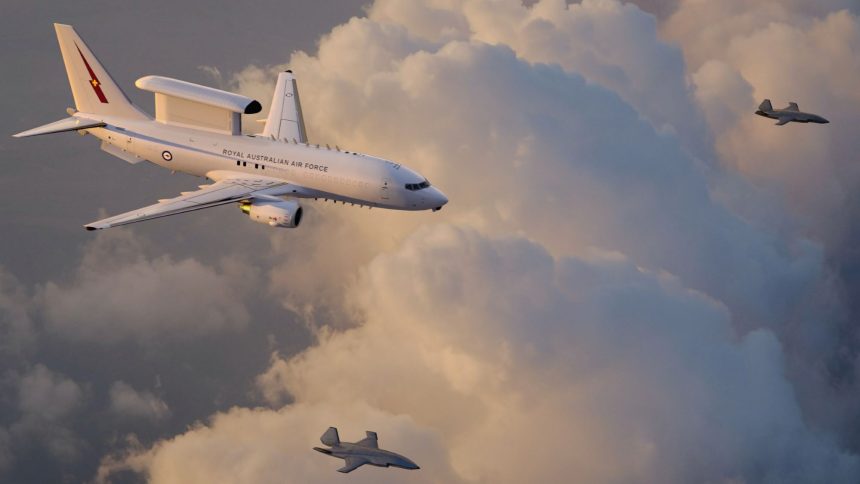A single operator aboard the E-7 took control of two MQ-28s, having them fly ahead to protect the crewed asset.
In a major milestone, two MQ-28A Ghost Bat unmanned aircraft teamed up with an E-7A Wedgetail AEW&C (Airborne Early Warning and Control) aircraft and conducted a mission against a simulated airborne target while being controlled by an operator aboard the E-7. The development was announced on Jun. 16, 2025, by Boeing Defence Australia, which designed the MQ-28 for the Royal Australian Air Force (RAAF).
The release highlighted that “a single operator onboard the E-7A took control of the uncrewed MQ-28s emulating the role they play in flying ahead of and protecting crewed assets.” The software used to control the MQ-28 was jointly developed by Boeing Defence Australia, Australia’s Defence Science and Technology Group and the U.S. Air Force Research Laboratory (AFRL).
So far however, neither Defence Australia nor the RAAF have released an official statement on the test, and it is not known when the test took place. The image released by Boeing is also a graphic rendition, and not an actual photograph.
This trial is part of tests with RAAF assets which will be conducted throughout this year, collectively known as Capability Demonstration 2025 (CD25). “CD25 will demonstrate MQ-28 operational effectiveness and how collaborative combat aircraft will integrate and operate with RAAF crewed assets,” said Boeing, adding that future test events will also include F/A-18F and F-35 fighter jets.
The MQ-28A Ghost Bat uncrewed aerial vehicle has achieved a significant milestone, with a single operator taking control of two Ghost Bat aircraft to conduct a mission against an airborne target in South Australia. #aviation #aerospacehttps://t.co/miB4uOMYtE pic.twitter.com/5Wr2wp4tpO
— Australian Aviation (@ausaviation) June 16, 2025
RAAF’s electromagnetic sensing, strike and manned-unmanned concept
An emerging concept within the RAAF is to employ a number of electromagnetic sensing, Electronic Intelligence (ELINT), Electronic Warfare (EW) and airborne radar platforms like the MC-55A Peregrine, E-7A Wedgetail and multirole aircraft like the F-35A Lightning II and the E/A-18G Growler into a single network for a combined domination of the attack, defense and electromagnetic sensing space. As it now turns out, the MQ-28A Ghost Bat is a vital element of this concept.
“This trial demonstrates family-of-systems integration, the strength of our open systems architecture, and is a critical first step towards integrating mission partners’ software and communications systems natively into the E-7A Wedgetail,” said Glen Ferguson, director MQ-28 Global Programs. “It not only validated a key element of the MQ-28 concept of operations, but also how collaborative combat aircraft can expand and enhance the role of the E-7A to meet future force requirements.”
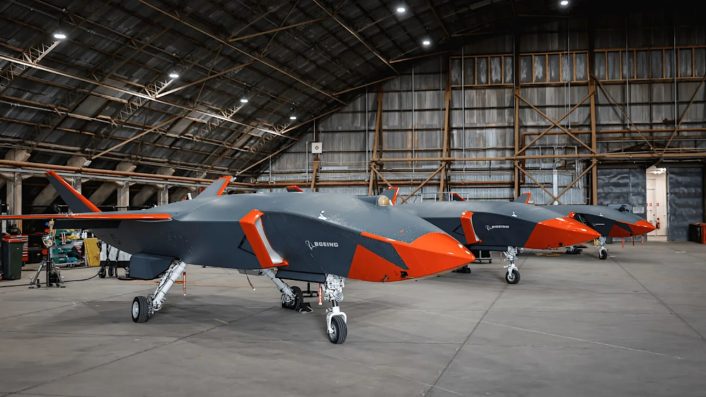
The heavily stealth-centric design has also been shown to have three different nose sections in computerized illustrations, with one sporting what seems like a FLIR/IRST (Forward-Looking Infrared/Infrared Search and Track). The MQ-28’s 1.5 cubic meter nose can hold interchangeable payloads for ISR (Intelligence, Surveillance and Reconnaissance), aerial radar surveillance and EW/ELINT sensors.
The latest test is nevertheless consistent with concept illustrations from Boeing that have shown the Ghost Bat flying with the E-7A Wedgetail, beside the F-15EX and the EA-18G Growler.
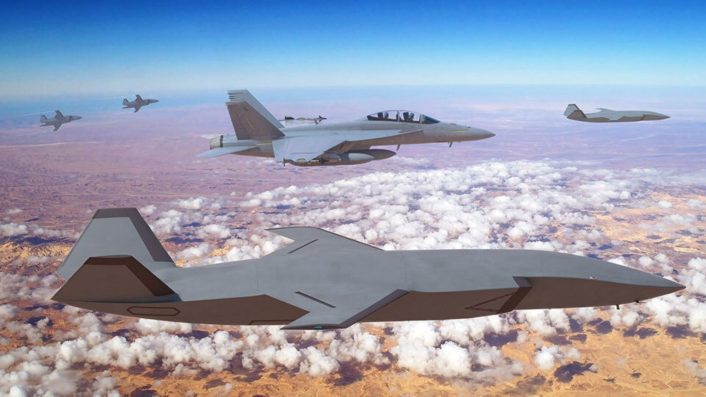
MQ-28A Ghost Bat
On Jun. 13, 2024, when the MQ-28A Ghost Bat was controlled for the first time by a RAAF pilot, Wing Commander Phil Parsons, as the platform’s first non-Boeing pilot, Ferguson described the Ghost Bat as being “designed to team with piloted aircraft through an ‘operator-in-the-loop’ approach.” Boeing says the Ghost Bat employs “AI (Artificial Intelligence) to work as a smart team with existing military aircraft to complement and extend airborne missions.”
Earlier in 2024, the Australian government allocated $259.5 million to further develop key systems for the Boeing MQ-28A and build three new aircraft in the Block 2 configuration. The Block 2 will have an enhanced design, improved capabilities, and additional sensors.
So far, eight Block 1 Ghost Bats have been manufactured, while the Block 2 were initially expected to be ready by 2025, with all of them participating in a critical capability demonstration exercise. Australia’s Minister for Defence Industry, Pat Conroy, said that one objective for the program, following the demonstration phase in 2025, will be the ability to produce MQ-28As at 10% of the cost of an aircraft such as the F-35A.
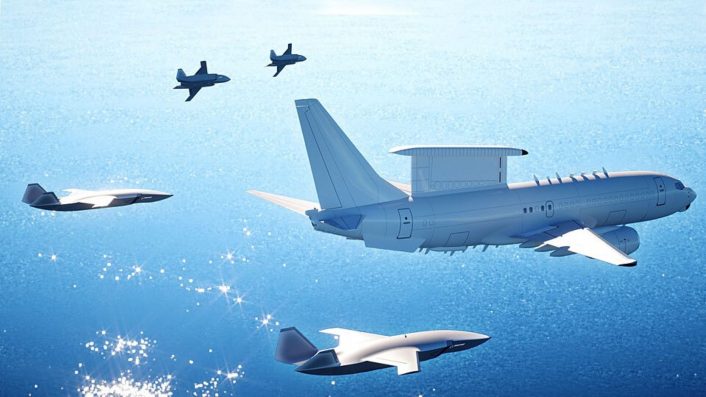
However, this possibility was riding upon the United States possibly looking at the Ghost Bat as a part of its Collaborative Combat Aircraft (CCA) program. In fact, the U.S. acquisition of MQ-28 would have brought down the development and manufacturing costs by spreading them out between both the nations.
In 2022, the Pentagon confirmed that it acquired at least one MQ-28 for research and development purposes for the U.S. Air Force. While an expanded acquisition plan has so far not been revealed, former Secretary of the Air Forc,e under the President Joe Biden administration, Frank Kendall referred to the Ghost Bast as a “technology feeder” for the CCA project.
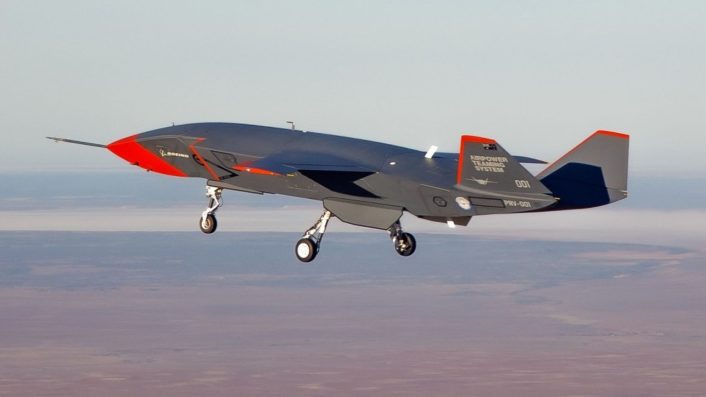
RAAF’s E-7A Wedgetail
The RAAF’s E-7A Wedgetail, of which six airframes are in service in the No. 2 Squadron at RAAF Base Williamtown, is itself currently undergoing a capability expansion. The aircraft has been certified to be refueled by a new tanker, after an aircraft received fuel from a U.S. Air Force KC-46A Pegasus earlier in Apr. 2025 near Edwards AFB, California, and the Mojave desert.
The interoperability and capability expansion test was also meant to gain experience and inform future test planning for the E-7A Wedgetail, of which Britain’s Royal Air Force and the U.S. Air Force are future operators.
We’ll be producing our first three Block 2 MQ-28 aircraft under a new agreement with @DefenceAust to advance our Ghost Bat uncrewed teaming capability and further the #MQ28 developmental pathway. pic.twitter.com/Cn1XdJMjiH
— Boeing Australia (@BoeingAustralia) February 9, 2024
New capabilities for the Ghost Bat
Boeing also announced during the Avalon Australian International Airshow in Mar. 2025 that the MQ-28A Ghost Bat would perform a live test launch of an air-to-air missile between late 2025 to early 2026. It would be the first weaponized counter-air use of the Ghost Bat, whose concept renditions and use has so far been described as ISR, electronic warfare and force multipliers for manned aircraft.
Boeing also confirmed that the eight active airframes, all under the Block 1 configuration, completed 102 test flights. As reported by The Aviationist in context of Saab providing equipment for Australia’s Ghost Bats, the Block 2s will be informed by results of the testing on the Block 1 aircraft.
Boeing has delivered the first MQ-28 Ghost Bat strike drone to the United States, which can work in conjunction with the F-35 Lightning II fifth-generation fighter.
The MQ-28 Ghost Bat is the first drone developed by Boeing Australia. Ghost Bat is designed for the Royal… pic.twitter.com/WpYCKt75Dj
— Lew Anno Support#Israel #Ukraine 24/2-22 (@anno1540) May 29, 2023
These Block 2 will not have significant airframe changes, with the only major change being the removal of the Block 1’s dogtooth wing. Internally the aircraft will get changes that will improve maintainability. Block 2 will also get a new Global Positioning System (GPS)/Inertial Navigation System (INS).

